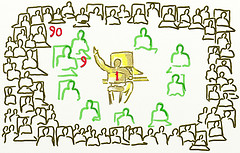The 90-9-1 rule, popularized by Jacob Nielsen, based on research by Will Hall, says that 90% of users in an online community are lurkers who don’t contribute, while 9% contribute sometimes and 1% contribute frequently.
Last year, Paul Schneider attempted to update this principle by looking at a relatively small data set of 15 clients and suggested that the the rule should now be 70-20-10.
Once in a while, I see someone comment or write a post about how 90-9-1 is dead or no longer relevant or something similar. Sooner or later, if it reaches enough people, someone will come along and suggest the 70-20-10 rule needs to be updated, too.
I think that, possibly because of the usage of the word “rule,” people take these principles too exactly and think that if they don’t fit within those exact numbers, that the principles themselves are wrong.
They aren’t. The point was never to say that the numbers themselves were hard and fast, just that a majority of the people who visit your community will be lurkers, a small percentage will contribute sometimes and a smaller percentage will contribute a lot. It could be 90-9-1, 70-20-10, 80-15-5, 68-24-8 or something else.
The point is to demonstrate participation inequality. How can you eliminate it participation inequality? As Nielsen says, you can’t. But, in his post, he also says that it isn’t about the exact numbers.
“Your only real choice here is in how you shape the inequality curve’s angle,” Nielsen writes. “Are you going to have the “usual” 90-9-1 distribution, or the more radical 99-1-0.1 distribution common in some social websites? Can you achieve a more equitable distribution of, say, 80-16-4? (That is, only 80% lurkers, with 16% contributing some and 4% contributing the most.)”
Years later, this is still correct. It’s not about some exact number, it is about understanding that participation inequality exists and then trying to shape the curve in a manner that you are comfortable with.

